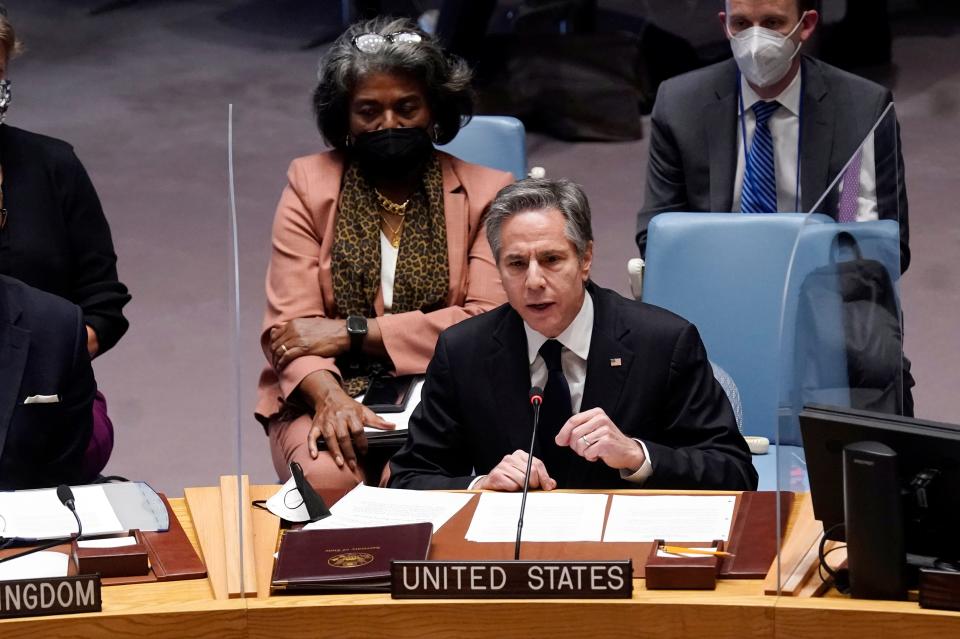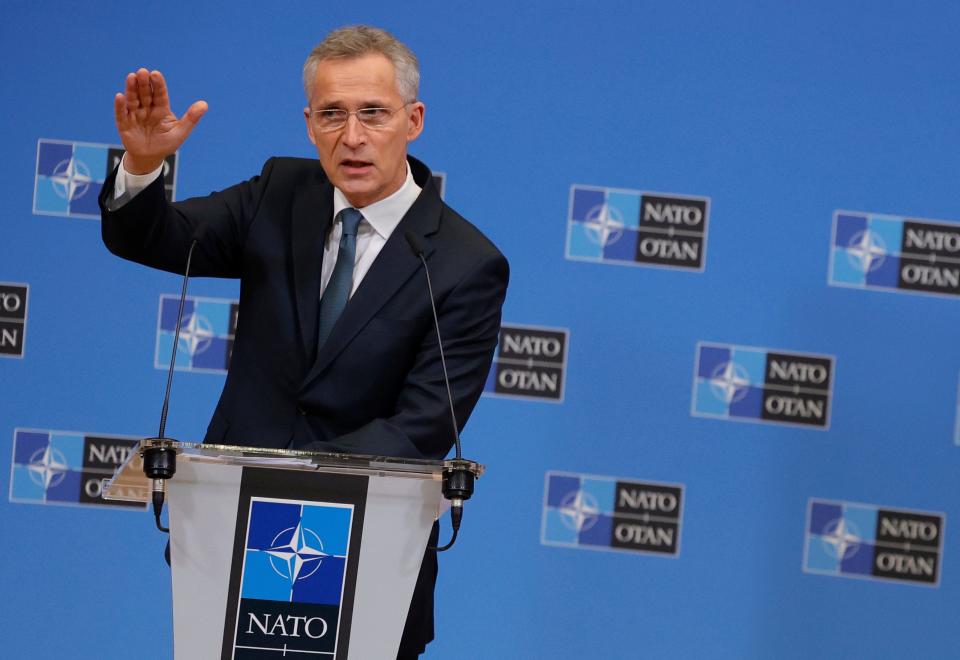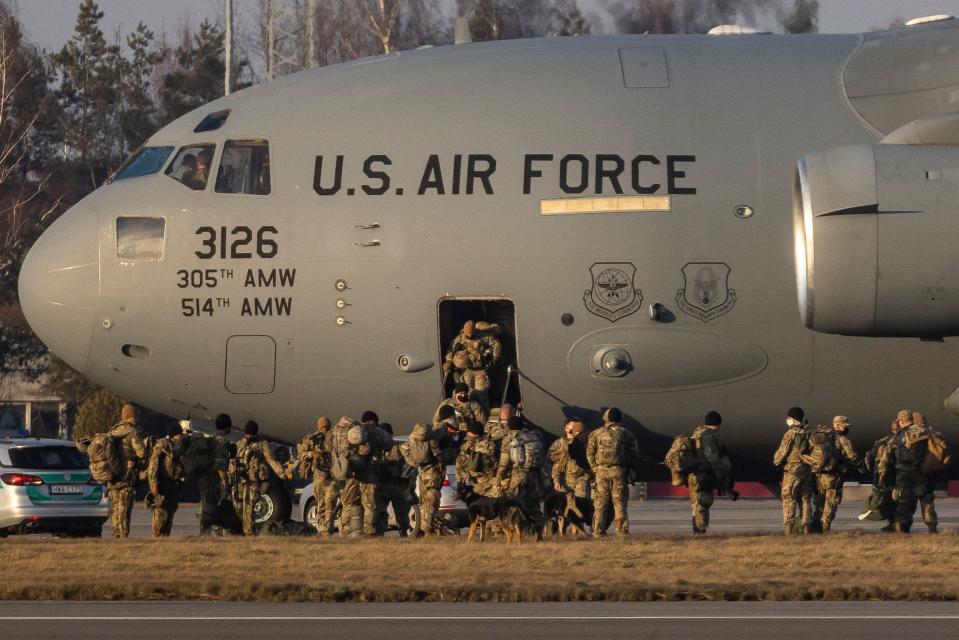Russia expels US diplomat; Blinken speaks at UN 'to prevent' a war: What we know
- Oops!Something went wrong.Please try again later.
Russia has sent an American diplomat home from Moscow as tensions remained at a peak Thursday in the conflict over Ukraine.
NATO allies accused Russia of misleading the world and disseminating "disinformation" by saying it was returning some troops to bases, charging that Moscow has instead added as many as 7,000 more troops near its tense border with Ukraine.
The Russian government, meanwhile, has responded to American security proposals, and the U.S. is evaluating the reply, Secretary of State Antony Blinken said. The U.S. and Russia have been trading replies on Moscow's demands over security concerns related to Ukraine. Russia wants guarantees that NATO never admit Ukraine and other former Soviet nations as members and that the alliance roll back troop deployments in other former Soviet bloc countries.
In Washington, President Joe Biden told reporters the threat of a Russian invasion is “very high” and could take place in the next several days. He cited reports that Russia is moving more troops along the border with Ukraine and may be engaged in a “false flag” operation to create a pretext for an invasion.
“Every indication we have is they're prepared to go into Ukraine, to attack Ukraine,” he said.
Biden said he still believes a diplomatic solution to the crisis is possible, which is why he asked Secretary of State Antony Blinken to deliver a statement to the U.N. Security Council on Thursday.
“There is a path – there is a way through this,” he said.
Biden said he has no plans to call Russian President Vladimir Putin.
Ahead of a U.N. Security Council meeting on a separatist region in eastern Ukraine, U.S. Ambassador to the U.N. Linda Thomas-Greenfield said on Twitter that "evidence on the ground is that Russia is moving toward an imminent invasion."
With Western fears high that Russia is planning to invade, tensions also spiked Thursday along the line that separates Ukrainian forces from Russia-backed separatists in the country's east, with the parties accusing each other of intensive shelling.
Ukraine's president: Volodymyr Zelenskyy, former actor, prepares for his greatest role yet
Blinken to meet Lavrov
U.S. Secretary of State Antony Blinken will meet his Russian counterpart in Europe late next week, said State Department spokesperson Ned Price in a statement.
"The Secretary noted in his remarks at the UN Security Council today that, because we believe the only responsible way to resolve this crisis is through diplomacy and dialogue, he had proposed to meet Foreign Minister Lavrov in Europe next week," Price said.
"The Russians have responded with proposed dates for late next week, which we are accepting, provided there is no further Russian invasion of Ukraine. If they do invade in the coming days, it will make clear they were never serious about diplomacy. We will continue to coordinate with our Allies and partners and push for further engagements with Russia through the NATO-Russia Council and OSCE," the statement concluded.
-- Deirdre Shesgreen
Blinken to Russia: Say you won't invade, then withdraw
Secretary of State Antony Blinken on Thursday called on Russia to unequivocally state it will not invade Ukraine – and to back that up by withdrawing troops amassed near their borders while sending diplomats to the negotiating table.
Speaking at a U.N. Security Council meeting, Blinken said he has invited his Russian counterpart to sit down with him in Europe next week. Those talks, in addition to proposed meetings at NATO and the Organization for Security and Co-operation in Europe, would pave the way for a “summit of key leaders,” he said.
“As lead diplomats for our nations,” Blinken said, “we have a responsibility to make every effort for diplomacy to succeed, to leave no diplomatic stone unturned.”
Blinken’s appearance at the United Nations was a last-minute addition to his schedule before he heads to Munich for a security conference, which Vice President Kamala Harris will also attend.
Thomas-Greenfield said the goal of Blinken’s address was to convey the gravity of the situation and to “emphasize the path toward de-escalation.”
“I am here today not to start a war,” Blinken told the Security Council, “but to prevent one.”

Blinken details how an attack could unfold
While Russia has said it’s withdrawing some of its troops, Blinken said that’s not happening and intelligence clearly indicates that Russia is “preparing to launch an attack against Ukraine in coming days.”
Before he spoke, Russian Deputy Foreign Minister Sergei Ryabko, warned Blinken against making a “baseless accusation” about an attack.
“I think we've had enough speculation on that,” he said, through an interpreter.
Ryabkov noted that Feb. 16 – the date that U.S. officials had indicated an invasion could start – has passed.
“Therefore, my advice to you is not present yourself in an awkward situation,” he added, before turning the microphone over to Blinken.
Instead, Blinken laid out what he said is “unfolding right now, today, as Russia takes steps down the path to war.”
He said Russia plans to manufacture a pretext – either a “violent event” that Russia can blame on Ukraine or an “outrageous accusation” leveled against the Ukrainian government. Russia could, for example, fabricate a terrorist bombing in Russia, invent a “discovery” of a mass grave, stage a drone strike against civilians or launch a fake or real attack with chemical weapons, he said.
Russia could then theatrically convene emergency meetings to address the “so-called crisis,” Blinken said.
“Next, the attack is planned to begin.” he said. “Russian missiles and bombs will drop across Ukraine. Communications will be jammed. Cyberattacks will shut down key Ukrainian institutions.”
Russian tanks and soldiers would then advance on key targets, including Ukraine’s capital, Blinken said. In addition to conventional attacks, Blinken said the U.S. has information indicating Russia will also target “specific groups of Ukrainians.”
By laying out that scenario in detail, Blinken said he hoped to push Russia to “choose a different path while there's still time.”
“If Russia doesn’t invade Ukraine, then we will be relieved that Russia changed course and proved our predictions wrong,” he said. “That would be a far better outcome than the course we're currently on. And we’ll gladly accept any criticism that anyone directs at us.”
Effects of a cyberattack: A Russian invasion could reach farther than Ukraine. How a cyberattack could affect you.
US diplomat expelled
The State Department confirmed Thursday that Russia had expelled a top American diplomat, U.S. Deputy Chief of Mission Bart Gorman, the second most senior official stationed at the U.S. Embassy in Moscow.
Gorman was expelled last week, according to an embassy spokesperson, who was not authorized to speak on the record.
“Russia’s action against our (deputy chief of mission) was unprovoked and we consider this an escalatory step and are considering our response,” said a State Department spokesman, who spoke on the condition of anonymity.
“We call on Russia to end its baseless expulsions of U.S. diplomats and staff and to work productively to rebuild our missions,” the spokesman added. ”Now more than ever, it is critical that our countries have the necessary diplomatic personnel in place to facilitate communication between our governments.”
More: What is a false flag? US says Russia may use the tactic to justify Ukraine invasion
Austin: US sees what Russia is doing
Asked about Moscow's troop buildup, U.S. Defense Secretary Lloyd Austin said the U.S. and its NATO partners “will closely match Russian words to Russian deeds, what they say to what they actually do.”
“We’ve seen some of those troops inch closer to that border. We see them fly in more combat and support aircraft," he said at NATO headquarters in Brussels. "We see them sharpen their readiness in the Black Sea. We even see them stocking up their blood supplies. You don’t do these sort of things for no reason, and you certainly don’t do them if you’re getting ready to pack up and go home."
NATO Secretary-General Jens Stoltenberg said the alliance was concerned "that Russia is trying to stage a pretext for an armed attack against Ukraine."
Earlier in the week, the Kremlin had said diplomatic efforts to ease the conflict were still possible. At the same time, it said both Tuesday and Wednesday that it was pulling troops from near the Ukrainian border. But a U.S. official later Wednesday said Russia had actually added troops, rather than withdrawn them, ratcheting up tension once again.
More: Is Russian going to invade Ukraine? Some images suggest pullback. US says not true.

"We have seen the opposite of some of the statements. We have seen an increase of troops over the last 48 hours, up to 7,000," said British Defense Secretary Ben Wallace ahead of a meeting Thursday of the western alliance in Brussels.
That squared with what a U.S. administration official said a day earlier.
British Armed Forces Minister James Heappey even called Russia's claim to be withdrawing troops "disinformation."
While the West warned the threat of invasion remains high, no attack materialized Wednesday, as some had feared.
More: Biden threatens devastating sanctions if Russia invades Ukraine. Here's what that might look like.
Satellite imagery suggests the Russian defense ministry's claim that it has started pulling back troops in some areas could be true, but military experts are skeptical.
Maxar Technologies, a space technology and intelligence company, captured images during the past week, showing a significant reduction of military vehicles in some locations where they had been massing during the past four months. But U.S., Ukrainian and NATO officials have taken a skeptical stance, with a U.S. official saying Wednesday that Russia has added as many as 7,000 troops along the Ukrainian border.
From Ukraine's eastern border
Separatist authorities in the Luhansk region reported an increase in Ukrainian shelling along the tense line of contact, describing it as a “large-scale provocation.” Separatist official Rodion Miroshnik said rebel forces returned the fire.
Ukraine disputed the claim, saying that separatists had shelled its forces, but they didn’t fire back. The Ukrainian military charged that shells hit a kindergarten, wounding two civilians, and cut power supply to half of the town.
There are concerns that a flare-up in the east could be used by Russia as a pretext for rolling across the border – though there was no immediate sign that the fighting was more intense than usual.
More: Ravaged by ongoing war, people in Ukraine's Luhansk region want the shooting to end
Yevgeny Pristinsky works at the checkpoint pushing wheelchairs with elderly people traveling across the so-called gray zone – the area between the breakaway Luhansk LNR region and the territory controlled by Ukraine – to collect their pensions.
Pristinsky found himself in a terrifying situation, in the middle of the Presidential Bridge, when he said the LNR opened fire. It was around 9 a.m., "which was unusual – they never shoot in the mornings, only after 5 p.m., and we stop working at 3 p.m.
"I was on the bridge between the two sides with my clients, the travelers – an old woman, her daughter and granddaughter. LNR fired mortar in our direction. I did not know what to do. The checkpoint shut down for about 10 minutes," he said.
Pristinsky added that the Ukrainian side responded a couple of times, and that a local kindergarten building's wall was hit and fell off.
"There were kids inside. And now Russians claim that Ukraine fired at its own schools and kindergartens. Now people are in panic waiting for 5 pm. This is a very dangerous moment because the Russian army is very close in Izvarino, they can use any response by Ukrainians as their reason to 'help the brother people' in LNR and move in."
More: Congress has tough words on Putin and Russia's aggression in Ukraine but can't agree on sanctions

Troops shifting into eastern Europe
Already the alliance has moved troops and military equipment into Eastern Europe – in a display of resolve of meant to deter any Russian aggression and underline its intent to defend NATO's eastern members, in the unlikely event that they too become a target.
The U.S. has started to deploy 5,000 troops to Poland and Romania. A further 8,500 more are on standby. Britain is sending hundreds of soldiers to Poland, offering more warships and planes, and doubling the number of personnel in Estonia. Germany, the Netherlands and Norway are sending additional troops to Lithuania. Denmark and Spain are providing jets for air policing in the Baltic Sea region.
Contributing: Anna Nemtsova, USA TODAY; Associated Press
This article originally appeared on USA TODAY: Ukraine: Russia expels US diplomat; Blinken calls for de-escalation

